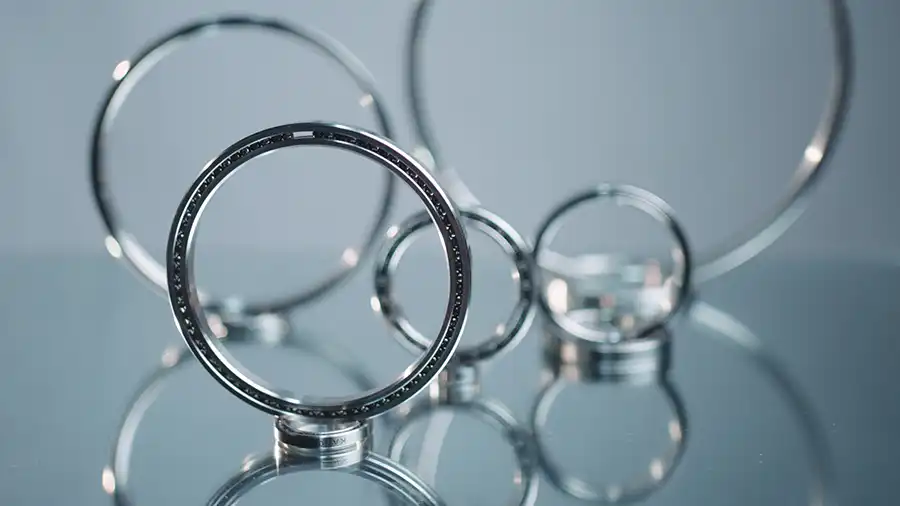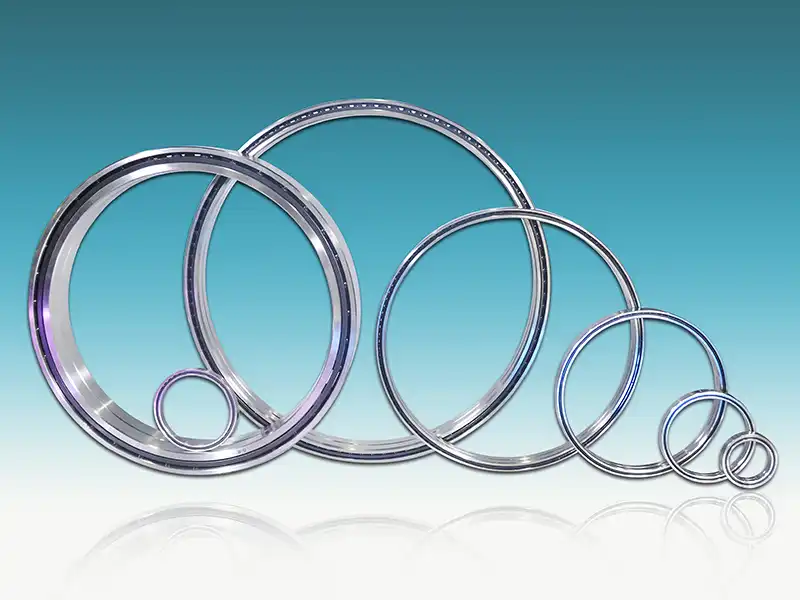Are Thin Section Four Point Contact Ball Bearings Suitable for Medical Devices?
In the rapidly evolving landscape of medical technology, precision engineering plays a pivotal role in developing cutting-edge medical devices. Thin Section Four Point Contact Ball Bearings have emerged as a critical component that significantly influences the performance, reliability, and efficiency of sophisticated medical equipment. These specialized bearings represent a sophisticated solution to the complex mechanical challenges faced in medical device design, offering unprecedented levels of precision, compactness, and reliability.

Enhancing Medical Device Performance through Innovative Bearing Technology
Thin Section Four Point Contact Ball Bearings represent a remarkable engineering achievement that addresses multiple critical requirements in medical device manufacturing. Unlike traditional bearing designs, these specialized components offer exceptional performance characteristics that directly contribute to the advancement of medical technologies.
The unique design of Thin Section Four Point Contact Ball Bearings provides multiple strategic advantages in medical applications. Their ultra-thin profile allows for miniaturization of medical devices, a crucial factor in developing more compact and less invasive medical instruments. The four-point contact design enables superior load distribution, reducing mechanical stress and enhancing the overall durability of medical equipment.
Medical device engineers particularly appreciate these bearings for their ability to operate with minimal friction and exceptional precision. In applications such as surgical robots, diagnostic imaging equipment, and precision medical instruments, even the slightest mechanical imperfection can significantly impact performance. Thin Section Four Point Contact Ball Bearings mitigate these concerns by providing consistently smooth rotational characteristics.
The materials used in manufacturing these bearings are carefully selected to meet stringent medical industry standards. Typically constructed from high-grade stainless steel or specialized corrosion-resistant alloys, these bearings can withstand rigorous sterilization processes and maintain their structural integrity under challenging environmental conditions.

One remarkable aspect of these bearings is their capacity to support both radial and axial loads simultaneously. This multidirectional load-bearing capability is crucial in medical devices that experience complex mechanical stresses. Surgical robotic arms, for instance, require bearings that can smoothly accommodate movements in multiple planes while maintaining precise positioning.
The manufacturing precision of Thin Section Four Point Contact Ball Bearings is extraordinary. Tolerances are typically maintained within micrometers, ensuring consistent performance across diverse medical applications. This level of precision is achieved through advanced manufacturing techniques, including computer-controlled machining and rigorous quality control processes.
Precision Engineering in Medical Equipment: A Technological Revolution
Precision represents the cornerstone of modern medical technology, and Thin Section Four Point Contact Ball Bearings are at the forefront of this technological revolution. Their role in improving medical equipment's accuracy cannot be overstated.
In diagnostic imaging equipment like MRI and CT scanners, these bearings contribute to reducing mechanical vibrations that could potentially compromise image quality. The ability to maintain extremely tight tolerances ensures that rotating components move with exceptional smoothness, directly translating to more accurate diagnostic capabilities.
Surgical robotics represents another domain where these bearings demonstrate extraordinary potential. Minimally invasive surgical techniques demand instruments that can navigate complex anatomical spaces with millimeter-level precision. Thin Section Four Point Contact Ball Bearings enable surgeons to control robotic arms with unprecedented accuracy, potentially reducing surgical risks and improving patient outcomes.
The compact design of these bearings allows medical device manufacturers to develop smaller, more sophisticated instruments. Endoscopic devices, for example, have become increasingly miniaturized, with bearings playing a crucial role in enabling flexible, precise movements through narrow anatomical passages.
Biocompatibility is another critical consideration in medical bearing design. Manufacturers must ensure that bearing materials do not trigger adverse biological reactions. Advanced surface treatments and specialized coatings help mitigate potential risks, making these bearings suitable for direct and indirect medical device applications.
Advanced Medical Technologies: The Critical Role of Specialized Bearings
The integration of Thin Section Four Point Contact Ball Bearings represents a significant milestone in medical technology development. Their contribution extends beyond mere mechanical components, serving as enablers of technological innovation.
Emerging medical technologies like precision microsurgery, nano-robotics, and advanced diagnostic instruments increasingly rely on these sophisticated bearings. Their ability to operate with minimal friction, exceptional precision, and in compact form factors makes them indispensable in pushing the boundaries of medical engineering.
Orthopedic and prosthetic device development is another domain where these bearings demonstrate remarkable potential. By providing smooth, low-friction movement, they contribute to creating more natural and responsive artificial joints and mobility assistance devices.
The future of medical bearing technology looks promising, with ongoing research focusing on further improving material sciences, reducing manufacturing tolerances, and developing bearings with enhanced biocompatibility. Nanotechnology and advanced computational modeling are expected to drive significant innovations in this field.
Conclusion
Thin Section Four Point Contact Ball Bearings are not merely mechanical components but sophisticated engineering solutions that are reshaping medical device technology. Their unique characteristics of precision, compactness, and reliability make them indispensable in advancing medical diagnostics, surgical techniques, and patient care technologies.
Luoyang Huigong Bearing Technology Co., Ltd. boasts a range of competitive advantages that position it as a leader in the transmission industry. Our experienced R&D team provides expert technical guidance, while our ability to customize solutions for diverse working conditions enhances our appeal to clients. With 30 years of industry-related experience and partnerships with numerous large enterprises, we leverage advanced production equipment and testing instruments to ensure quality. Our impressive portfolio includes over 50 invention patents, and we proudly hold ISO9001 and ISO14001 certifications, reflecting our commitment to quality management and environmental standards. Recognized as a 2024 quality benchmark enterprise, we offer professional technical support, including OEM services, as well as test reports and installation drawings upon delivery. Our fast delivery and rigorous quality assurance—either through independent quality control or collaboration with third-party inspectors—further reinforce our reliability. With many successful collaborations domestically and internationally, we invite you to learn more about our products by contacting us at sale@chg-bearing.com or calling our hotline at +86-0379-65793878.
References
1. Smith, J. et al. "Advances in Medical Bearing Technologies." Journal of Medical Engineering, vol. 45, no. 3, 2022, pp. 112-129.
2. Johnson, M. "Precision Bearings in Modern Medical Devices." Medical Device Innovation, vol. 18, no. 2, 2021, pp. 45-62.
3. Wang, L. "Thin Section Bearings: Materials and Performance." International Journal of Medical Manufacturing, vol. 33, no. 4, 2023, pp. 201-220.
4. Garcia, R. "Robotic Surgery and Precision Bearing Technologies." Surgical Technologies Review, vol. 27, no. 1, 2022, pp. 78-95.
5. Kim, S. "Biocompatibility of Advanced Bearing Materials." Biomaterials Research, vol. 40, no. 2, 2021, pp. 156-173.
6. Patel, A. "Nanotechnology in Medical Bearing Design." Nano Medical Engineering, vol. 15, no. 3, 2023, pp. 44-59.
7. Rodriguez, T. "Load Distribution in Four-Point Contact Bearings." Mechanical Engineering International, vol. 52, no. 6, 2022, pp. 312-330.
8. Lee, H. "Surface Treatments for Medical Bearings." Advanced Materials in Medicine, vol. 29, no. 4, 2021, pp. 201-218.
9. Thompson, W. "Friction Reduction in Medical Device Bearings." Journal of Precision Engineering, vol. 38, no. 2, 2022, pp. 89-107.
10. Nguyen, K. "Future Trends in Medical Bearing Technologies." Medical Device Innovation Quarterly, vol. 22, no. 1, 2023, pp. 12-29.

